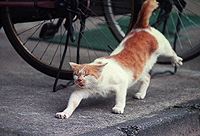|
Top Picks || Arts & Entertainment || Business & Economy || Education & Society ||
HOW IS LIFE IN THE BIG CITY? Tokyo's First Feline Survey October 6, 1998  Another Tokyo resident taking a stroll. (Jiji Press) Although cats are common house pets in Japan, their presence has given rise to a fair share of problems. Approximately 10,000 complaints relating to such matters as cat excrement and abandoned cats are filed in Tokyo each year. This led the Tokyo metropolitan government to conduct its first-ever survey on cat habitation in Tokyo. Unlike dogs, which by law must be registered and whose numbers are therefore on record, there has been no clear documentation of the population of cats up to now. There are estimated to be some 1.16 million felines in Tokyo. Of these, 600,000 are indoor house cats. The remaining 560,000, including 110,000 stray cats, have free roam of the city streets. Children's Illnesses Prompt Survey The survey, conducted by the Public Health Bureau between February and May 1998, consisted of a questionnaire given to 3,000 households and a head count of outdoor cats in Tokyo. In order to calculate the number of outdoor cats, a private survey company measured off 5- to 10-kilometer routes in several parts of the prefecture, and then tallied the number of cats appearing within five meters of the route. The survey was carried out three times during the same day for each route--in the morning, early afternoon, and evening. The survey findings revealed a total of 1.16 million cats. Of these, some 1.05 million are pets, a ratio of approximately one cat per 4.5 households. Many apartment complexes forbid pets, but 11% of households in multiunit dwellings owned at least one cat, not much lower than the 14% for single-unit households. Based on numbers made available by a rabies prevention law requiring the registration of dogs, 288,000 dogs are on record as living in Tokyo, giving felines a decided edge in number. Slightly more than half, or 52.5%, of all cat owners keep their pets indoors, while the rest allow the cats to spend all or part of their time outdoors. A majority (51.5%) of owners place some kind of identification on their cats, but of those who keep their cats outdoors, only 28.6% tag their pets, making it difficult to distinguish between cats with an owner and those that are stray. In terms of toilet training, while 99% of all house cats are trained to use a litter box, less than 15% of outdoor cats are so trained. Standards for Coexistence Compared to dogs, cats are much more independent and therefore harder to train and manage. Many cat-lovers profess that this very independence is a cat's best trait. In a densely populated metropolis like Tokyo, however, common sense dictates that there be standards applied to cat ownership. With opinion thus divided, forging a common ground between humans and cats could face a steep road ahead.
 Edited by Japan Echo Inc. based on domestic Japanese news sources. Articles presented here are offered for reference purposes and do not necessarily represent the policy or views of the Japanese Government. Edited by Japan Echo Inc. based on domestic Japanese news sources. Articles presented here are offered for reference purposes and do not necessarily represent the policy or views of the Japanese Government.
|
